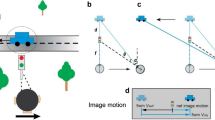Abstract
One of the ways that we perceive shape is through seeing motion1,2,3. Visual motion may be actively generated (for example, in locomotion), or passively observed. In the study of the perception of three-dimensional structure from motion, the non-moving, passive observer in an environment of moving rigid objects has been used as a substitute1 for an active observer moving in an environment of stationary objects; this ‘rigidity hypothesis’ has played a central role in computational and experimental studies of structure from motion4,5. Here we show that this is not an adequate substitution because active and passive observers can perceive three-dimensional structure differently, despite experiencing the same visual stimulus: active observers' perception of three-dimensional structure depends on extraretinal information about their own movements. The visual system thus treats objects that are stationary (in an allocentric, earth-fixed reference frame) differently from objects that are merely rigid. These results show that action makes an important contribution to depth perception, and argue for a revision of the rigidity hypothesis to incorporate the special case of stationary objects.
This is a preview of subscription content, access via your institution
Access options
Subscribe to this journal
Receive 51 print issues and online access
$199.00 per year
only $3.90 per issue
Buy this article
- Purchase on Springer Link
- Instant access to full article PDF
Prices may be subject to local taxes which are calculated during checkout



Similar content being viewed by others
References
Wallach, H. & O'Connell, D. N. The kinetic depth effect. J. Exp. Psychol. 45, 205–217 (1953).
Braunstein, M. L. Depth perception in rotating dot patterns. J. Exp. Psychol. Hum. Percept. Perf. 72, 415–420 (1962).
Johansson, G. Visual perception of biological motion and a model for its analysis. Percept. Psychophys. 14, 210–211 (1973).
Ullman, S. The Interpretation of Visual Motion (MIT Press, Cambridge, 1979).
Koenderink, J. J. Optic flow. Vision Res. 26, 161–179 (1986).
Rogers, B. & Graham, M. Motion parallax as an independent cue for depth perception. Perception 8, 125–134 (1979).
Rogers, B. & Graham, M. Similarities between motion parallax and stereopsis in human depth perception. Vision Res. 22, 261–270 (1982).
Rogers, S. & Rogers, B. J. Visual and nonvisual information disambiguate surfaces specified by motion parallax. Percept. Psychophys. 52, 446–452 (1992).
Dijkstra, T. M., Cornilleau-Pérès, V., Gielen, C. C. & Droulez, J. Perception of three-dimensional shape from ego- and object-motion: comparison between small- and large-field stimuli. Vision Res. 35, 453–462 (1995).
van Damme, W. J. & van de Grind, W. A. Non-visual information in structure-from-motion. Vision Res. 36, 3119–3127 (1996).
Landy, M. S., Maloney, L. T., Johnston, E. B. & Young, M. Measurement and modeling of depth cue combination: in defense of weak fusion. Vision Res. 35, 389–412 (1995).
Attneave, F. & Frost, R. The determination of perceived tridimensional orientation by minimum criteria. Percept. Psychophys. 6, 391–396 (1969).
Longuet-Higgins, H. C. & Prazdny, K. The interpretation of a moving retinal image. Proc. R. Soc. Lond. B 208, 385–397 (1980).
Todd, J. T. Visual information about rigid and non-rigid motion: a geometric analysis. J. Exp. Psychol. Hum. Percept. Perf. 8, 238–252 (1982).
Wallach, H., Weisz, A. & Adams, P. A. Circles and derived figures in rotation. Am. J. Psychol. 69, 48–59 (1956).
Adelson, E. H. Rigid objects that appear highly non-rigid. Invest. Ophthal. Visual Sci. 26 (Suppl.), (1985).
Sinha, P. & Poggio, T. Role of learning in three-dimensional form perception. Nature 384, 460–463 (1996).
Sparrow, J. E. & Stine, W. W. The perceived rigidity of rotating eight-vertex geometric forms: extracting nonrigid structure from rigid motion. Vision Res. 38, 541–556 (1998).
Ames, A. Visual perception and the rotating trapezoidal window. Psychol. Monogr. 65, (1951).
Ittelson, W. H. The Ames Demonstrations in Perception (Princeton Univ. Press, Princeton, 1952).
O'Brien, J. & Johnston, A. When texture takes precedence over motion in depth perception. Perception 29 437–452 (2000).
Wade, N. J. & Hughes, P. Fooling the eyes: trompe l'oeil and reverse perspective. Perception 28, 1115–1119 (1999).
Papathomas, T. V. See how they turn: Falso depth and motion in Hughes's reverspectives. Proc. SPIE 3959, 506–517 (2000).
Gibson, J. J. The Ecological Approach to Visual Perception (Houghton-Mifflin, Boston, 1979).
Reinhardt-Rutland, A. H. Perceiving surface orientation: Pictorial information based on rectangularity can be overridden during observer motion. Perception 22, 335–341 (1993).
Wallach, H. Perceiving a stable environment when one moves. Annu. Rev. Psychol. 38, 1–27 (1987).
Ono, H. & Steinbach, M. J. Monocular steropsis with and without head movement. Percept. Psychophys. 48, 179–187 (1990).
Snyder, L. H., Grieve, K. L., Brotchie, P. & Andersen, R. A. Separate body- and world-referenced representations of visual space in parietal cortex. Nature 394, 887–891 (1998).
Panerai, F., Hanneton, S., Droulez, J. & Cornilleau-Pérès, V. A 6-dof device to measure head movements in active vision experiments: Geometric modeling and metric accuracy. J. Neurosci. Meth. 90, 97–106 (1999).
Acknowledgements
We thank M. Ehrette and P. Leboucher for designing and building the head tracker.
Author information
Authors and Affiliations
Corresponding author
Rights and permissions
About this article
Cite this article
Wexler, M., Panerai, F., Lamouret, I. et al. Self-motion and the perception of stationary objects. Nature 409, 85–88 (2001). https://doi.org/10.1038/35051081
Received:
Accepted:
Issue Date:
DOI: https://doi.org/10.1038/35051081
This article is cited by
-
Visual Perception of Heading in the Syndrome of Oculopalatal Tremor
The Cerebellum (2021)
-
Active vision in immersive, 360° real-world environments
Scientific Reports (2020)
-
Multisensory effects on somatosensation: a trimodal visuo-vestibular-tactile interaction
Scientific Reports (2016)
-
Illusory Tactile Motion Perception: An Analog of the Visual Filehne Illusion
Scientific Reports (2015)
-
Tactile suppression of displacement
Experimental Brain Research (2010)
Comments
By submitting a comment you agree to abide by our Terms and Community Guidelines. If you find something abusive or that does not comply with our terms or guidelines please flag it as inappropriate.



